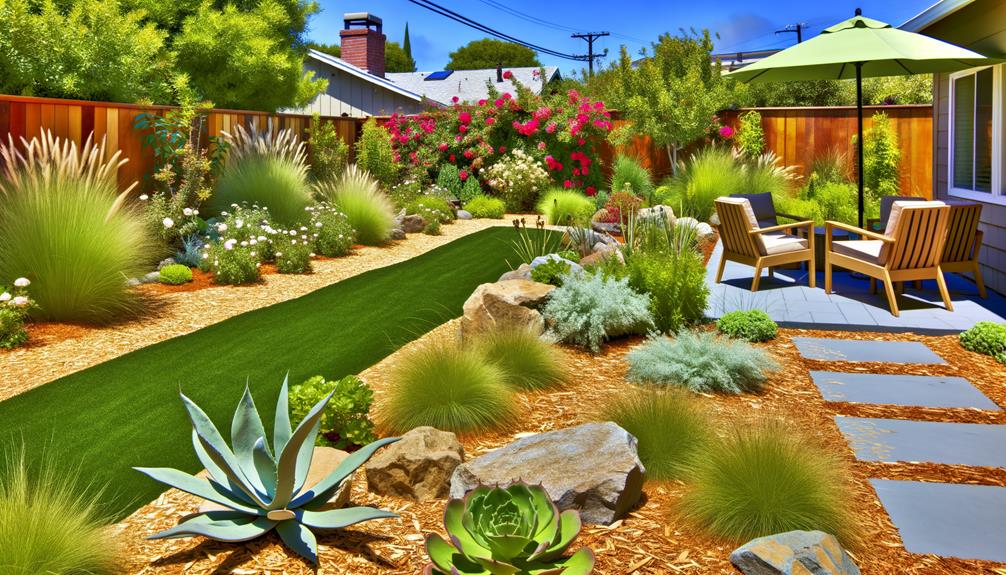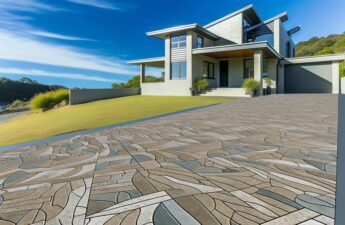You step outside into your small backyard, a blank canvas waiting to be transformed into a picturesque oasis.
As you gaze upon the barren landscape, you can't help but wonder how to create a stunning design that requires minimal effort and conserves water.
Fear not, for xeriscaping ideas are here to save the day. By incorporating native plants, clever hardscape features, and water conservation techniques, you can turn your small backyard into a haven of beauty and tranquility.
But that's not all, there's also the creative use of space and maintenance tips that will leave you wanting to know more.
Plant Selection
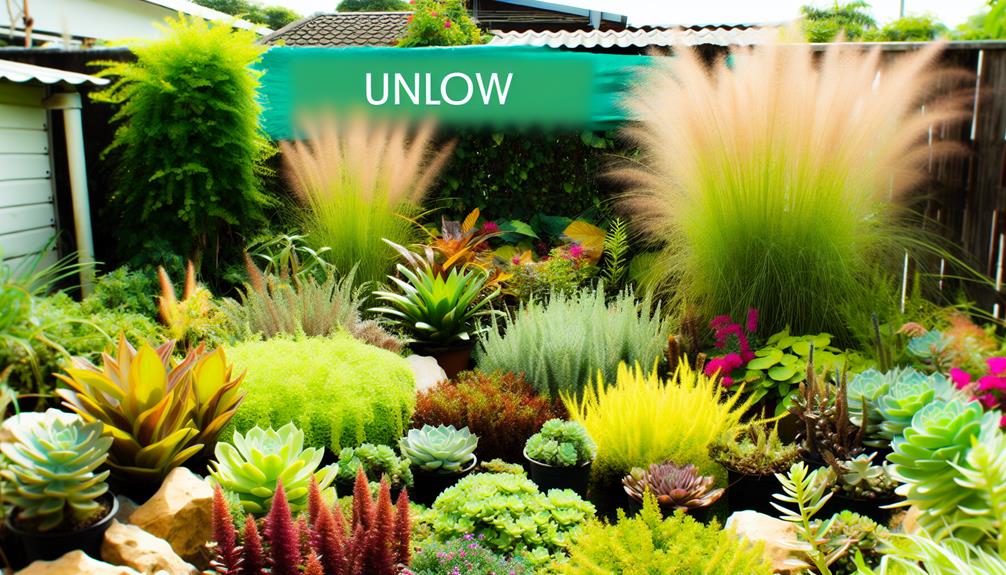
When selecting plants for your small backyard landscape design, it's important to choose native and well-adapted species that are drought-tolerant and low-water-use to minimize water consumption. Incorporating xeriscape ideas into your garden design can help create a visually appealing and sustainable landscape that requires less water and maintenance.
Opting for native plants is a great way to ensure that your garden thrives in its natural environment. Native plants are already well-adapted to the local climate and soil conditions, making them more drought-tolerant and resilient. By using native plants in your front yard landscaping, you not only conserve water but also support the local ecosystem.
Consider plants that are known for their drought tolerance and low water requirements. Succulents, herbs, and other water-efficient plant varieties are excellent choices for xeriscape design. These plants have adapted to survive in arid conditions, making them ideal for areas with limited water availability.
Grouping plants with similar water needs together is another effective strategy for managing irrigation and conserving water. By creating zones in your yard based on water requirements, you can ensure that each plant receives adequate moisture without wasting water on plants that don't need it.
Hardscape Features
To enhance the visual appeal and functionality of your small backyard landscape design, incorporate hardscape features that add texture and interest to the overall aesthetic. Hardscape features, such as decorative rocks, can be strategically placed throughout your garden to create visual interest and add texture to the landscape.
Additionally, incorporating paver walkways can't only enhance the overall design of your outdoor space but also improve functionality by providing a clear path for movement.
When designing your hardscape features, consider utilizing natural drainage techniques, such as incorporating gravel, to help retain soil moisture and prevent water wastage. This not only benefits the plants in your garden but also aligns with the principles of xeriscape design.
Furthermore, creating seating areas with materials like flagstones, pavers, or crushed granite can provide a relaxing and inviting space for outdoor enjoyment.
To ensure efficient water usage, you can integrate drip irrigation systems into your hardscape design. This allows you to minimize water waste and efficiently hydrate your plants, while also maintaining the overall aesthetic of your landscape.
Water Conservation Techniques
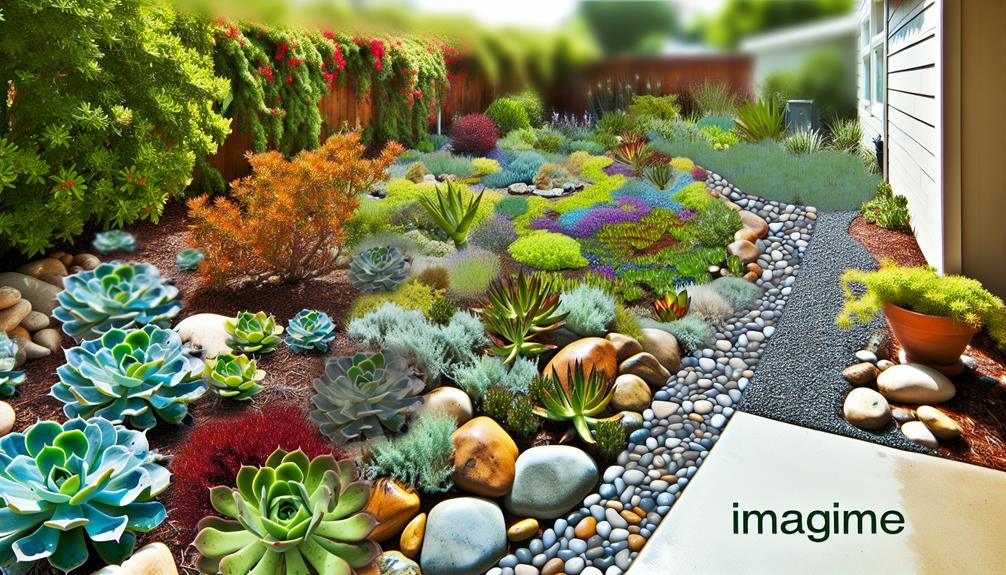
Implementing water conservation techniques is essential for reducing water consumption and maintaining a sustainable small backyard landscape design.
One effective method is using drip irrigation systems. These systems deliver water directly to the plant roots, minimizing water waste through evaporation or runoff.
Another technique is the use of rain barrels to capture and utilize rainwater. This not only saves water but also reduces the strain on municipal water supplies.
Choosing the right plants is also crucial for water conservation. Opt for native grasses and drought-tolerant plants that are adapted to the local climate. These plants require less water, reducing overall water consumption in your yard. Additionally, grouping plants with similar water requirements together can optimize watering practices and minimize water usage.
Mulching is another important water conservation technique. By adding a layer of mulch around plants, moisture is retained in the soil, reducing the need for frequent watering. Mulch also helps to reduce weed growth, giving your yard a neater appearance and reducing competition for water resources.
Creative Use of Space
To optimize your small backyard landscape design and make the most of every space, get creative with the use of space by incorporating unique and functional elements. One way to do this is by utilizing small nooks and corners for potted plants, creating a vertical garden effect. This not only adds greenery but also maximizes the available space.
Another idea is to incorporate multi-functional furniture, such as benches with hidden storage, to maximize space efficiency. These benches can provide seating while also serving as a storage solution for gardening tools or outdoor accessories.
Consider installing hanging or vertical planters to add greenery without taking up precious ground space. These planters can be attached to walls or fences, creating a visually appealing display of plants.
Creating a cozy seating area can also be achieved by using built-in benches or retaining walls along the perimeter. These not only provide seating but also define the space and create a sense of intimacy.
To add depth and visual interest to your small backyard, implement raised beds or tiered planters. These can be used to showcase drought-resistant plants, such as buffalo grass, which require minimal water and maintenance.
Incorporating garden paths, such as gravel paths, can lead the eye and create a sense of movement within the space. Additionally, consider adding rock gardens or a rain garden to not only enhance the aesthetics but also promote rainwater recycling and reduce water evaporation.
Maintenance Tips
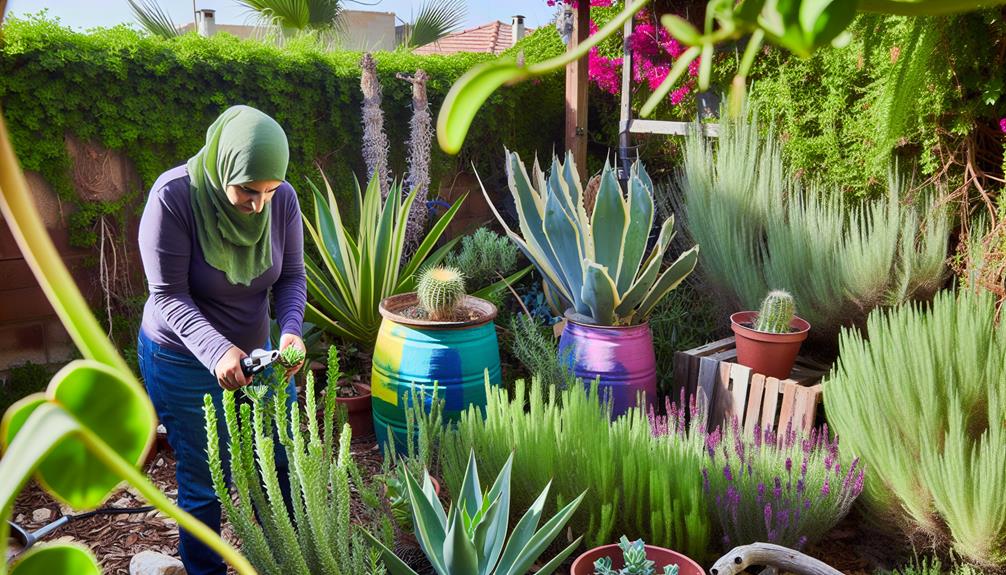
One important aspect of maintaining your small backyard landscape design is to use drip irrigation to minimize water waste and ensure efficient watering. By implementing a drip irrigation system, you can direct water directly to the roots of your plants, reducing the amount of water lost to evaporation and runoff. This not only helps conserve water, but also saves you money on your water bills.
Another key maintenance tip is to apply a generous layer of organic or inorganic mulch around your plantings. Mulch helps to conserve moisture in the soil, preventing evaporation and reducing the need for frequent watering.
Additionally, grouping plants with similar water requirements together can streamline your watering and maintenance efforts. By doing so, you can adjust your watering schedule and irrigation system to meet the needs of each group, optimizing water usage and ensuring the health of your plants. It's also worth considering relocating existing plants into more advantageous groupings based on their water needs and growing conditions. This will help you create a more efficient and sustainable landscape design.
